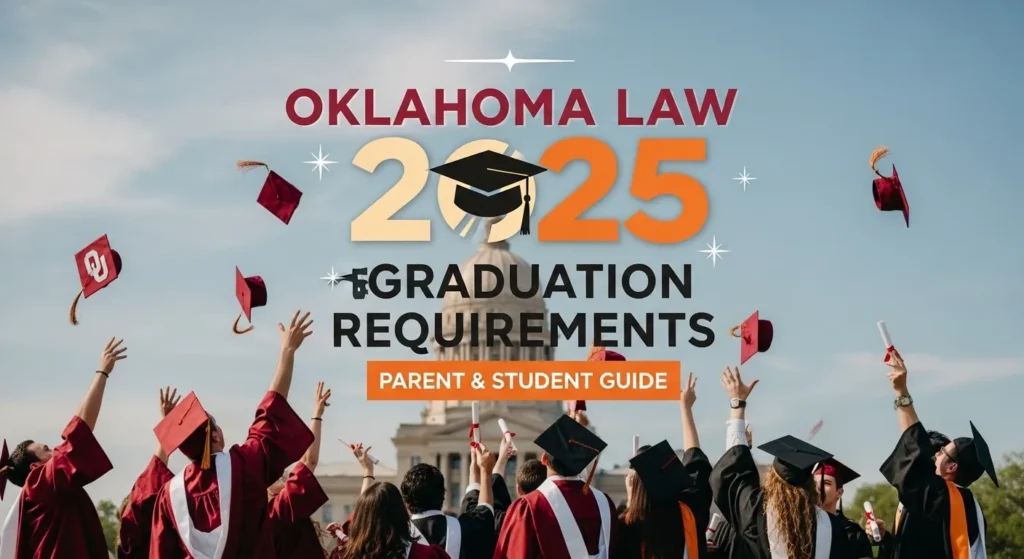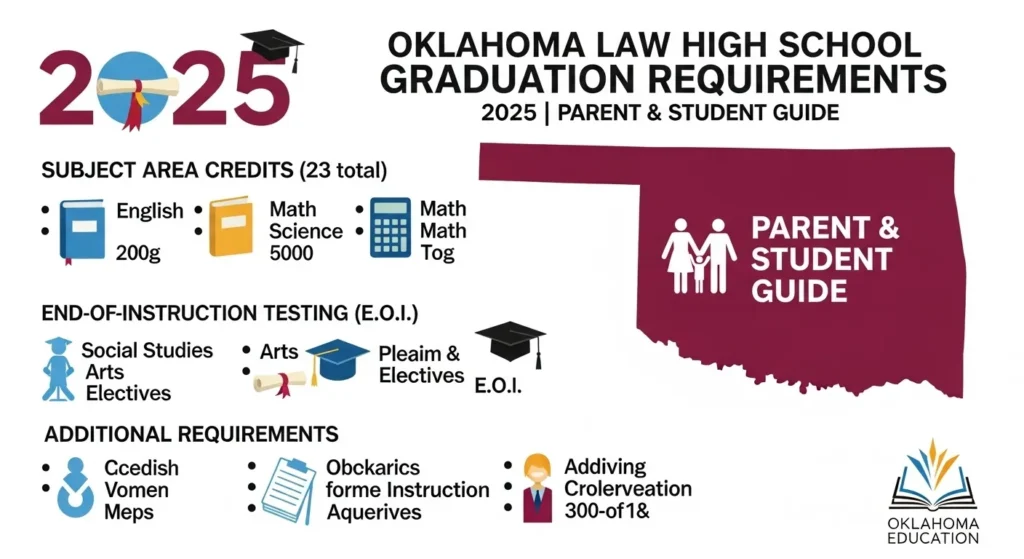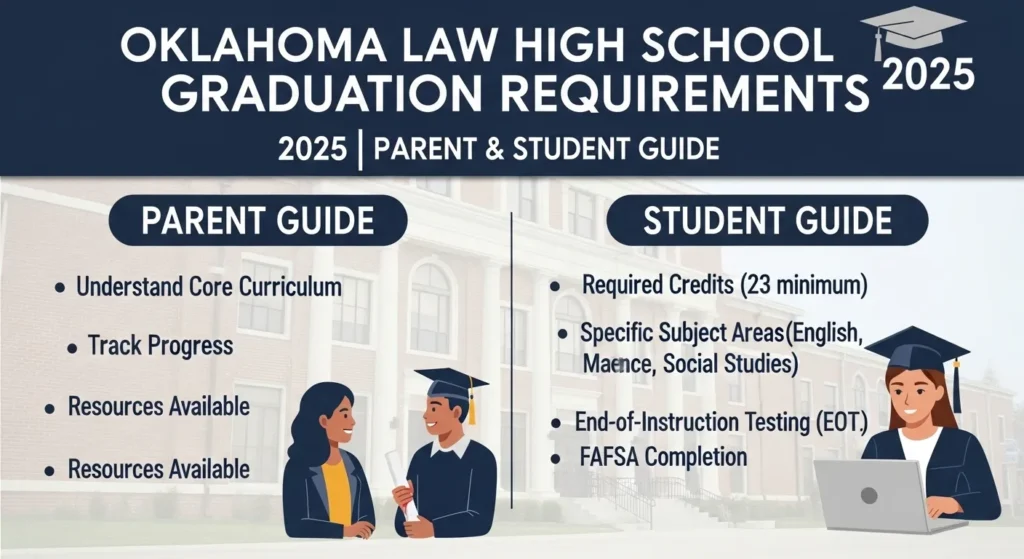Table of Contents
Graduation is one of the biggest milestones in a young person’s life, but in ‘oklahoma law high school graduation’, the rules for earning that diploma have changed dramatically in recent years. With the passage of House Bill 3278 (the Graduation Act of 2024), students, parents, and educators face a new landscape of academic and career preparation.
Whether you’re a parent worried about FAFSA requirements, a teacher adjusting lesson plans, or a student trying to understand what counts toward your diploma, this guide explains everything in clear, actionable terms.
As an educator who has guided high school seniors through Individual Career Academic Plans (ICAPs) since 2019, I’ve seen how these requirements can either empower or overwhelm students. This article aims to make the path forward simple.
Background on Oklahoma’s Graduation Law Changes

What Is House Bill 3278?
In late April 2024, Oklahoma lawmakers passed HB 3278, known as the Graduation Act of 2024. It sailed through the House with a 95–2 vote, then passed the Senate as an emergency measure 35–11. By May, Gov. Kevin Stitt had signed it into law.
Who Wrote the Bill and Why?
The legislation was authored by Rep. Rhonda Baker (R-Yukon) and Sen. Adam Pugh (R-Edmond). It was heavily supported by the State Chamber of Oklahoma, which pushed for reform to align graduation requirements with the state’s workforce needs.
Goals of the Graduation Act of 2024
- Eliminate the confusing two-track diploma system (College/Work Ready vs. CORE).
- Create one diploma standard with clear, minimum requirements.
- Ensure students are better prepared for college, skilled trades, or military service.
Key Effective Dates and Student Cohorts
Oklahoma has revised graduation requirements multiple times over the past decade. Here’s the timeline that matters:
| Year / Class | Key Policy Change |
|---|---|
| 2016–2018 | OVCA Board of Education adopted and revised graduation policies. |
| 2019–2020 (Class of 2023) | Students required to complete an Individual Career Academic Plan (ICAP). |
| 2021–2022 | Citizenship test (U.S. naturalization exam) added as a graduation requirement. |
| Class of 2025 | FAFSA submission required to graduate. |
| 2025–2026 school year | New HB 3278 rules take effect for students entering 8th grade. |
| Class of 2030 | First full graduating class under the new 23-unit curriculum. |
Visual SEO tip: Include a timeline graphic labeled “Timeline of Oklahoma Graduation Requirement Changes, 2016–2030.”
The New Minimum Curriculum Unit Requirements
Starting with the 2025–2026 school year, all students must complete 23 curriculum units (or sets of competencies) to graduate with a standard diploma.
English (4 Units)
- Grammar, Composition, Literature, or other English courses.
Mathematics (4 Units)
- Required: Algebra I + (Geometry or Algebra II).
- Options for other 2 units: Statistics, Calculus, Computer Science, locally approved application courses.
- Eighth-grade Algebra I counts if taught by a certified high school teacher.
Science (3 Units, Lab-Based)
- Biology I, Physical Science (Chemistry or Physics), plus one additional advanced or application-based science.
History & Citizenship (3 Units)
- U.S. History (1), Oklahoma History (0.5), U.S. Government (0.5), plus one elective in History, Civics, or Geography.
Pathway Units (6 Units)
- Flexible choices aligned with ICAP, including:
- Advanced Placement (AP) courses.
- Career Tech or apprenticeship.
- Fine arts, world language, JROTC, or dual credit college classes.
Electives (3 Units)
- Approved by local district board of education.
Visual SEO tip: Add a table comparing old CORE vs. new HB 3278 diploma paths. Alt text: “Comparison chart of Oklahoma diploma requirements before and after HB 3278.”
Oklahoma Law High School Graduation Requirements

In addition to coursework:
- State Testing: Students must participate in all mandated assessments.
- Financial Literacy Passport: 14 required competencies, including credit cards, budgeting, loans, and identity theft.
- OVCA Students: At least 25% of credits (6 out of 23) must be earned directly at OVCA.
Transitional Flexibility – HB 2672’s Emergency Clause
Another bill, HB 2672, added an emergency clause allowing schools to implement the updated requirements as early as 2024–2025, provided parents or guardians approve.
- Optional for early adopters.
- Districts must formally notify the State Department of Education with course descriptions by July 1, 2025.
Impacts on Students, Families, and Educators
Students
- More flexibility to choose career-aligned pathways.
- FAFSA requirement ensures financial aid opportunities.
Parents
- Must prepare earlier for college/career planning.
- Need to stay engaged with ICAP and school communications.
Educators
- Responsibility to integrate ICAPs and ensure compliance.
- Pressure to balance academic rigor with real-world application.
First-hand insight: “As a counselor, I’ve found FAFSA submissions intimidating for many first-generation families. The new requirement could increase stress but also ensure students don’t miss out on aid.”
Workforce and Higher Education Context
The changes didn’t happen in a vacuum. Data shows why reform was urgent:
- 44% of Oklahoma business leaders say education/workforce readiness is their top issue (2023 poll).
- College enrollment has declined 17.9% since 2010.
- Nearly 50% of Oklahoma graduates don’t enroll in college their first year.
- Example: Tulsa Union Public Schools created a construction training program in 2020, already reaching 1,000+ students.
Addressing Common Concerns and Misconceptions
Did Gov. Stitt Require Military Service to Graduate?
No. His December 2024 comments about “college, career tech, or military” were ideas, not law. His office clarified there is no military mandate.
Is There Still a Choice Between CORE and College/Work Ready?
No. HB 3278 establishes one standard diploma path.
Can Eighth-Grade Courses Count Toward High School Credit?
Yes, if taught by a certified high school teacher (example: Algebra I).
Practical Guidance for Families

Parent/Student Checklist
- Confirm your student’s graduation cohort year.
- Track ICAP progress starting freshman year.
- Plan FAFSA submission in senior year.
- Schedule yearly counselor meetings.
- Explore Career Tech, AP, or dual enrollment options early.
Useful Resources
Closing Words
Oklahoma’s Graduation Act of 2024 reshapes the way students earn their diplomas, balancing academic standards with workforce readiness. While the transition may feel complex, the goal is clear: to prepare graduates not just for college, but for real careers and financial independence.
👉 Next Step: Talk to your school counselor about how HB 3278 affects your student’s path, and subscribe to Oklahoma DOE updates for official guidance.
FAQs
What is the new law about graduating high school in Oklahoma?
HB 3278, the Graduation Act of 2024, sets a single diploma path with 23 credits, FAFSA, ICAP, testing, and financial literacy requirements.
What are the requirements to graduate high school in Oklahoma?
Students need 23 credits, pass state tests, complete ICAP, FAFSA, financial literacy, and required subjects in English, math, science, and history.
Did you graduate from high school legal or not legal?
Graduation is legal if all state and district requirements are met; diplomas are issued only by accredited schools under state law.
What is the minimum requirement to graduate high school?
Starting 2025–26, Oklahoma requires a minimum of 23 credits, including core subjects, pathway units, electives, ICAP, FAFSA, and state testing.
Can you graduate high school at age 20?
Yes, students can legally graduate by age 20 if they meet all state requirements; eligibility depends on district policies and completion status.
📚 References
- Oklahoma Legislature. House Bill 3278 (Graduation Act of 2024). Retrieved from https://www.oklegislature.gov
- Oklahoma Legislature. House Bill 2672 (Emergency Clause for Graduation Requirements). Retrieved from https://www.oklegislature.gov
- Oklahoma State Department of Education. Graduation Requirements & ICAP. Retrieved from https://sde.ok.gov
- Oklahoma State Regents for Higher Education. College Enrollment Data and Trends. Retrieved from https://www.okhighered.org
- Education Data Initiative. College Enrollment Declines in Oklahoma Since 2010. Retrieved from https://educationdata.org
- State Chamber of Oklahoma. Support for HB 3278: Workforce & Education Alignment. Retrieved from https://okstatechamber.com
- Tulsa World. Union Public Schools’ Construction Training Program Helps 1,000+ Students. Retrieved from https://tulsaworld.com
- Fox25 News Oklahoma. Gov. Stitt Clarifies Comments on Military Service & Graduation. Retrieved from https://okcfox.com
- U.S. Department of Education. FAFSA Official Site. Retrieved from https://studentaid.gov
- Oklahoma Virtual Charter Academy (OVCA). Board of Education Graduation Policy Revisions (2016–2023). Retrieved from https://okvirtual.net
- National Center for Education Statistics (NCES). Trends in High School Graduation & Workforce Readiness. Retrieved from https://nces.ed.gov
✅ Disclaimer: This article provides an overview of Oklahoma’s graduation law changes for informational purposes only. For official requirements, always consult the Oklahoma State Department of Education or your school district.
Author’s Perspective: Liam Everett
Liam Everett is an education policy analyst and former high school counselor with over 12 years of experience in Oklahoma’s K–12 system. He has advised on state curriculum reforms, worked directly with students on Individual Career Academic Plans (ICAPs), and writes extensively about graduation policy, workforce readiness, and higher education trends.





